If the interior of your home is analogous to the brain, then that would make the roof comparable to a skull. In other words, it protects the delicate interior of your home from the outside elements. However, despite its importance, the roof accounts for only 3% of the total house construction cost and sadly the right roof types are not adapted to one`s architectural solution, roofs are are often simply overlooked. That is mainly due to the ignorance of people. While an inexpensive Gable roof might save you some cash, it might end up doing irreparable damage in case you live in an area prone to cyclones or tornadoes. On the flip-side, if your area is far from windy, a Gable roof will definitely be more fitting. In fact, it will be more useful compared to a hip roof.
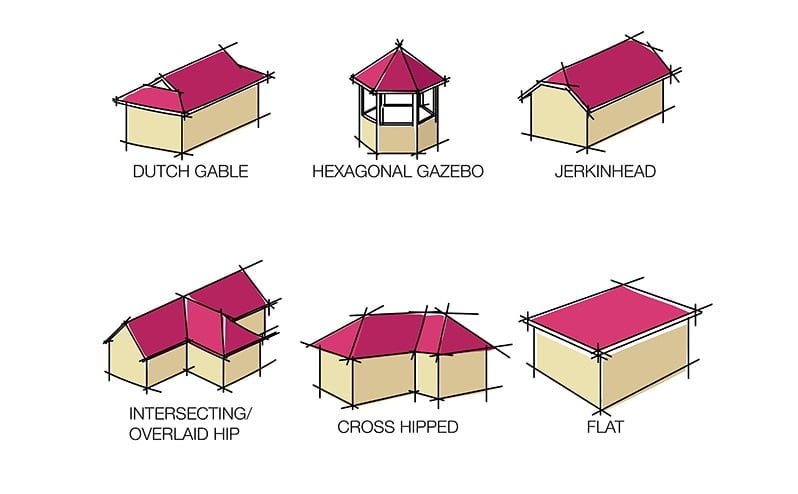
Why you ask? Well, to find the answer to that question and more, you need to go through this article first.
What are you waiting for?
Read along to find out everything you need to know about various roof structures.
Most Popular Roof Types
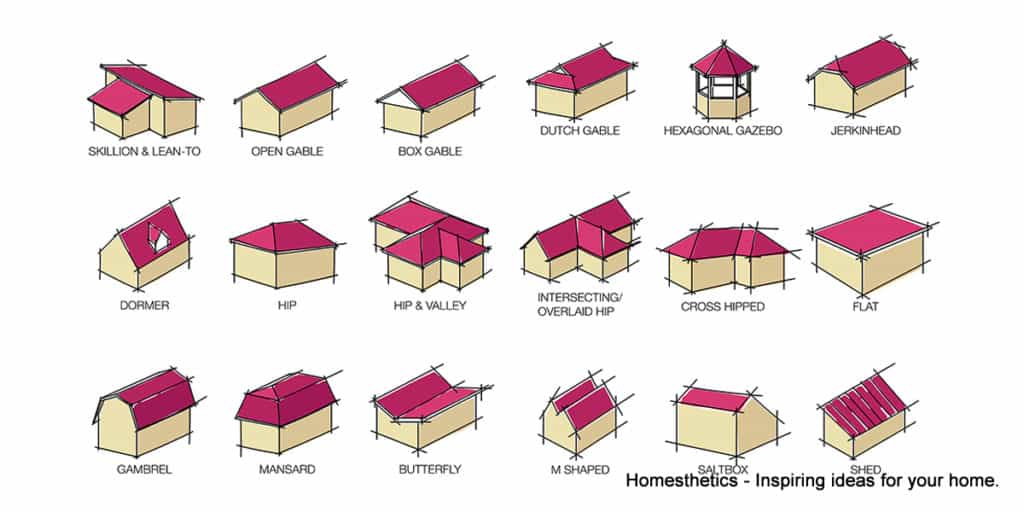
via homesthetics
1. Open Gable Roof
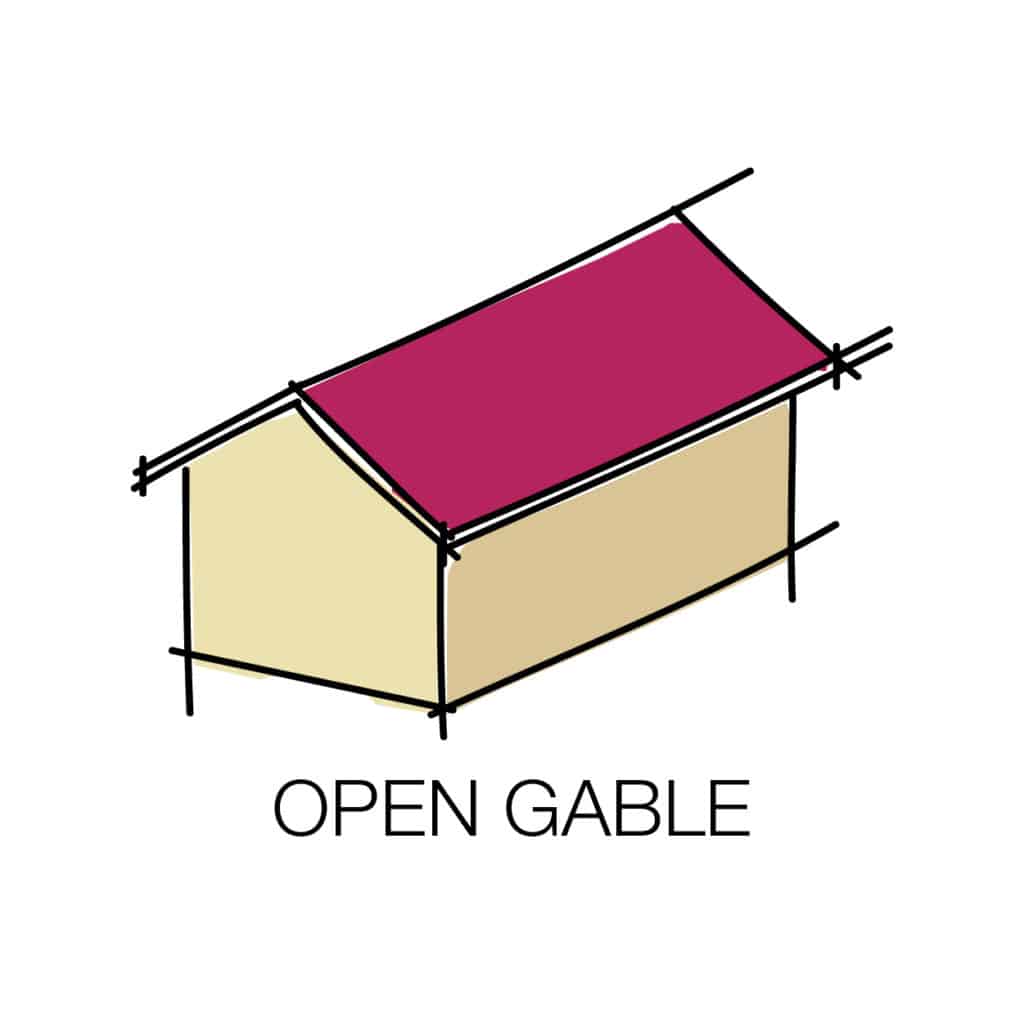
What better way to start our extensive roof guide than with the highly popular Open Gable Roof? But, before we get into the details, let us first explore Gable Roofs in general. Gable roofs have been used for time immemorial. In fact, they were used quite generously in ancient Roman and Greek architecture. What makes them so popular?
Well, for starters, they are comparatively inexpensive and also have a wide range of versatility when it comes to the design. Moreover, gabled roofs have a simple design principle which makes working on them quite easy when compared to the other complex roof structures in this article. However, that is not all; gabled roofs are also incredibly weather resistant and offer great protection from rain and snow.
Now that you have a clearer picture of what a gabled roof is, let us explore Open Gable Roof structures. Open gabled roofs are possibly the most common gabled roof structures used in the US. The main distinguishing feature of this structure is that the triangular extension at each end of the house is open.
The following are the two types of Open Gable Roofs based on the direction the Gable is facing:
- Front Gable Roof. In this structure, the front-gabled building faces the street with its gable. Buildings with this type of roof were extremely common in the medieval Gothic period. You can still find buildings with this type of roof structure in many German city streets. The image that follows shows a building with a front gabled roof.
 via Pinterest
via Pinterest
- Side Gable Roof. In this case, the sloping side of the Gable faces the streets. Buildings that came up in the later Renaissance period were influenced by this structure. The next image illustrates a building with a side-gabled roof.
2. Box Gable Roof
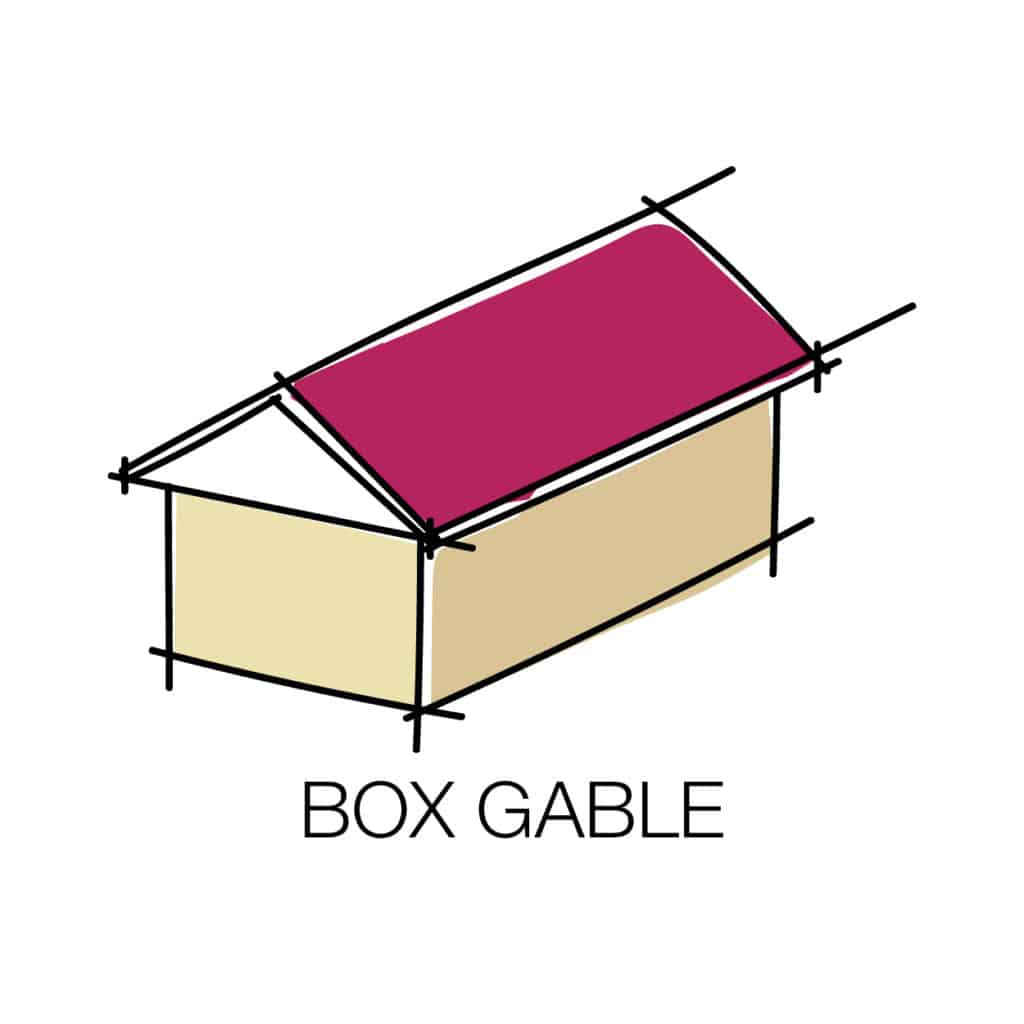
Box gabled roofs are extremely similar to open Gable roofs, with one small exception. On box-gabled roofs, the triangular extension at each end of the house is closed off instead of being opened. That is the only difference between these two structures.
Whether you want the triangular extension at each end to be closed or open is more of a personal choice than a practical one. However, we can tell you that the use of extra materials in the case of box-gabled roofs will definitely make it a little more expensive than open-gabled roofs. If you are on a tight budget, we suggest you go for the open gabled roof structure for your house. Below an image illustrates a standard building with a box-gabled roof structure.

via Wikipedia
3. Skillion and Lean-to Roof

The Skillion and Lean-to-Roof structures are quite commonly used in modern homes. A standalone skillion roof has a single slope which resembles the roof of a shed. When the Skillion Roof is combined with a lean-to roof, it results in a sleek and modern look as seen in the illustration below.
Combining these different roof structures together has an aesthetic benefit. It allows you to build walls of varying heights, just like the house featured in the illustration below. Interestingly, this roof structure does not have a roof ridge like every other roof. That is primarily because of the varying elevation level of the sloping structures.
 via houzz
via houzz
4. Dormer Roof
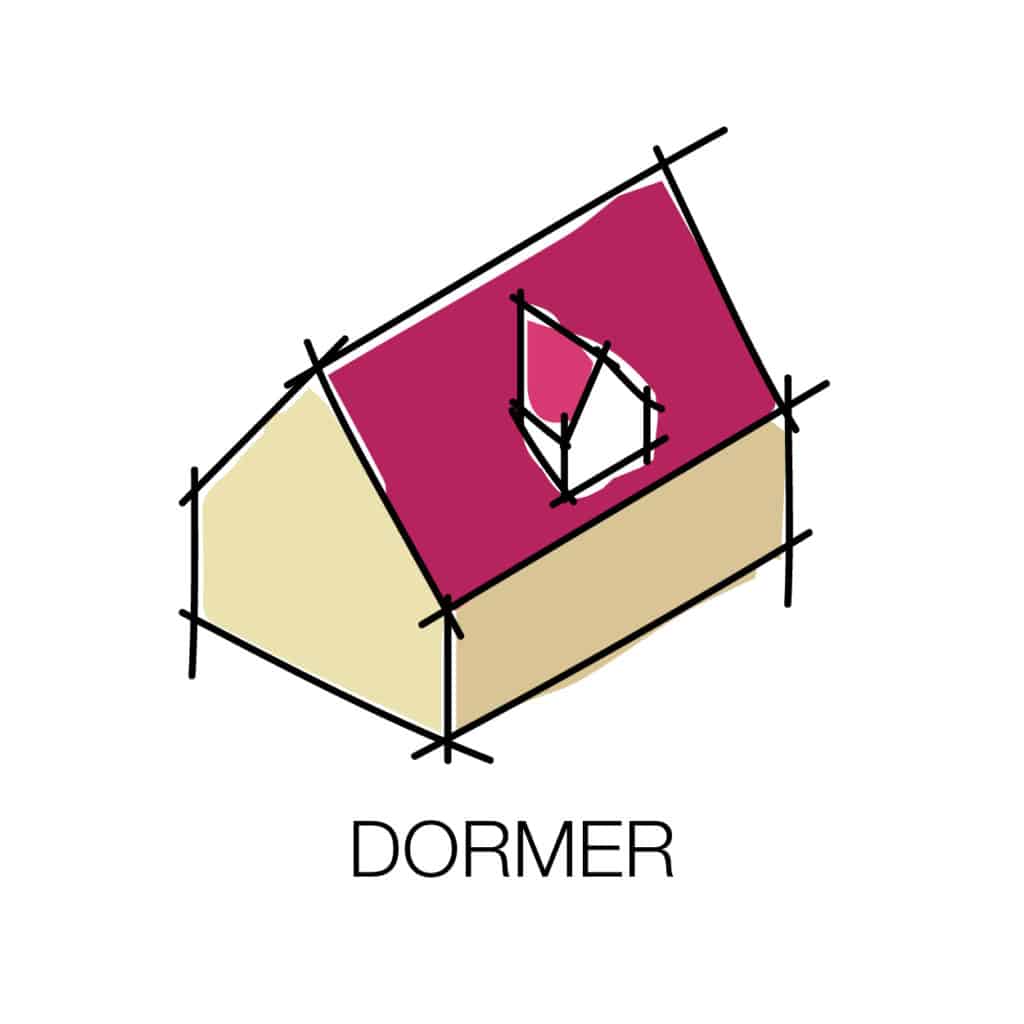
Next up on our list is the Dormer Roof. Now, the Dormer Roof isn't a completely different roof structure, rather it features an additional structure on top of an existing roof structure. This roofed structure usually contains a window and it projects vertically outwards beyond the plane of a pitched roof. The photo below shows a standard Gable Roof house with two Gable Dormer structures.
While dormers can drastically improve the aesthetics of the building, they are also extremely practical as they can be used to extend the interior space whilst inviting additional light inside.
Various types of dormer structures that are commonly used in buildings follow.
- Gable Fronted Dormer. Gable Fronted Dormers have protruding windows with gabled roofs. This type of dormer is by far the most common as it is comparatively less expensive to build compared to the other dormers on this list.
- Hip Roof Dormer. Hip Roof Dormers are also quite commonly used in buildings. While a standard Gable Fronted Dormer has two sloping sides, this dormer structure has an additional sloping structure in the front.
Whether hip-roof dormers are more attractive than Gable fronted dormers is up for debate. However, this type of dormer structure is generally more expensive compared to a simple Gable Fronted Dormer. - Flat Roof Dormer. As its name suggests, the roofed structure of this dormer is flat and does not have any ridges. However, for practical purposes, sometimes the flat roof is slightly inclined to let rainwater slide off. In case you live in an area with heavy rainfall, we suggest you go for sloping roofed dormers instead of flat ones.
- Shed Dormer. Shed dormers are quite similar to flat-roof dormers and do not have any ridges. However, unlike flat roof dormers, shed dormers have a greater level of inclination for the roofed structure. This is certainly more practical in case you live in an area with high rainfall.
- Wall Dormer. Now, a Wall Dormer is not an entirely different dormer structure. Rather it is a dormer that is positioned in such a way that it rises vertically with the wall of the building. In other words, the face of this dormer is co-planar with the face of the wall below it. These Wall Dormers usually feature a gabled roof structure on top.
- Eyebrow or Eyelid Dormer. This type of Dormer places more importance on the design rather than the functionality. As its name suggests, this low and wide dormer has a curved roof that resembles an eyelid.
- Link Dormer. There can essentially be two types of link dormers; one which connects one part of the roof with another or another which houses the chimney. The latter is similar to a wall dormer, with the addition of a chimney.
- Bonneted Dormer. Also known as a segmental dormer, this type of arched roof dormer is commonly found in Victorian structures. They are mainly built for improved aesthetics and not for practicality.
- Nantucket Dormer. These are possibly the largest type of dormers. The entire structure can be broken down into three segments, out of which the outer two segments are simply gable dormers. The middle segment features a shed dormer and it connects both the gable dormers together.
- Lucarne. This type of dormer usually appears on the slope of a Gothic spire. These dormers are usually slender and gable-fronted.
- Blind or False Dormer. As its name suggests, these dormers aren't built with functionality in mind. These dormers are used purely to improve the aesthetics of a building and they are not accessible from the interior. In fact, these false dormers can be an afterthought.
5. Hip Roof
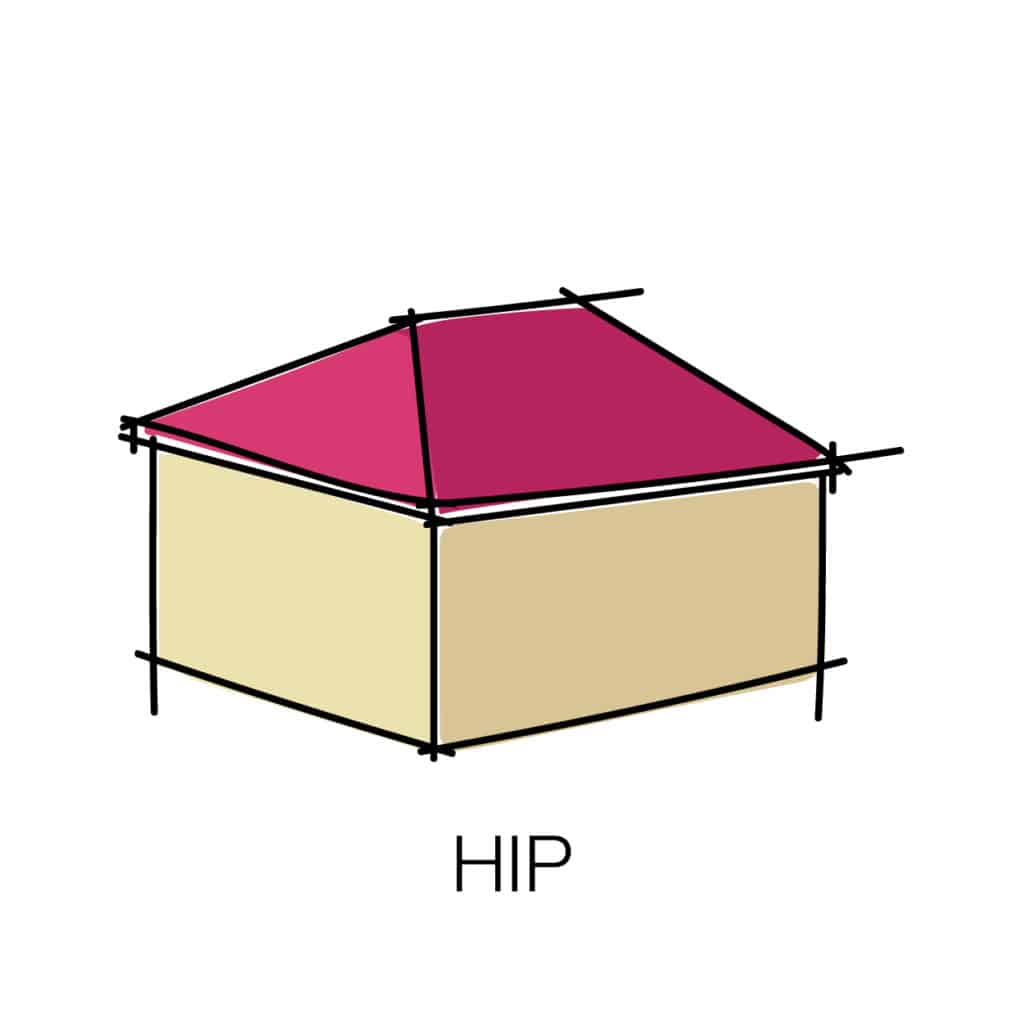
If there was a major flaw with the structural design of gable roofs, then that would be the fact that the triangular extensions at each end do not provide the side walls with sufficient protection from the rain. One way to solve the problem would be to make the roofs protrude further.
However, if you have limited horizontal space, then that would not be advisable. In that case, you will require a Hipped roof for your building. So, what exactly is a hipped roof? In comparison to simple gabled roofs which do not have sloping structures on 2 sides of the building, hipped roofs have slopes on all sides. Other than additional protection from the rain, hipped roofs are also better suited in windy environments.
But, there is a downside to installing hipped roofs, and that is the cost. They are more expensive compared to a simple Gable Roof. Moreover, the sloping sides mean that there will be less usable attic space, as illustrated by the image below.
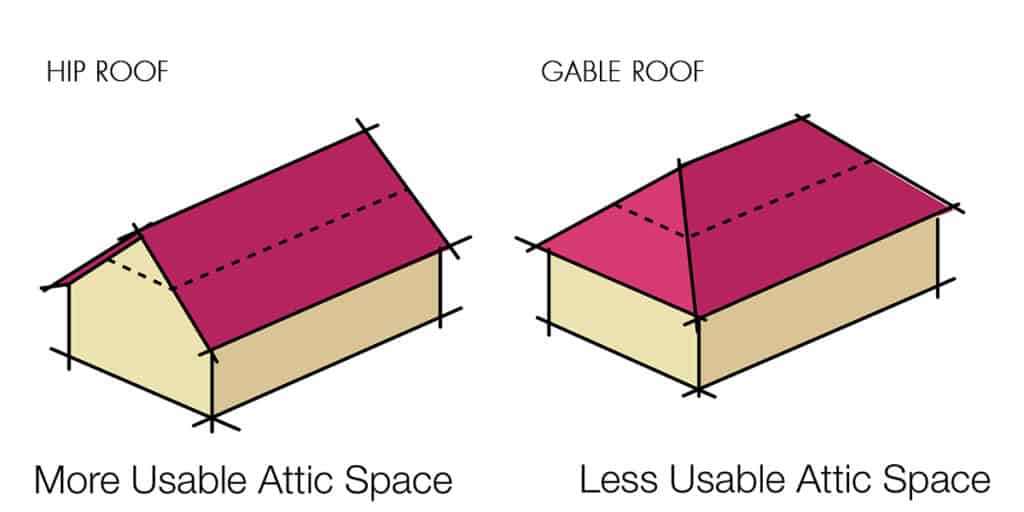
6. Hip and Valley Roof
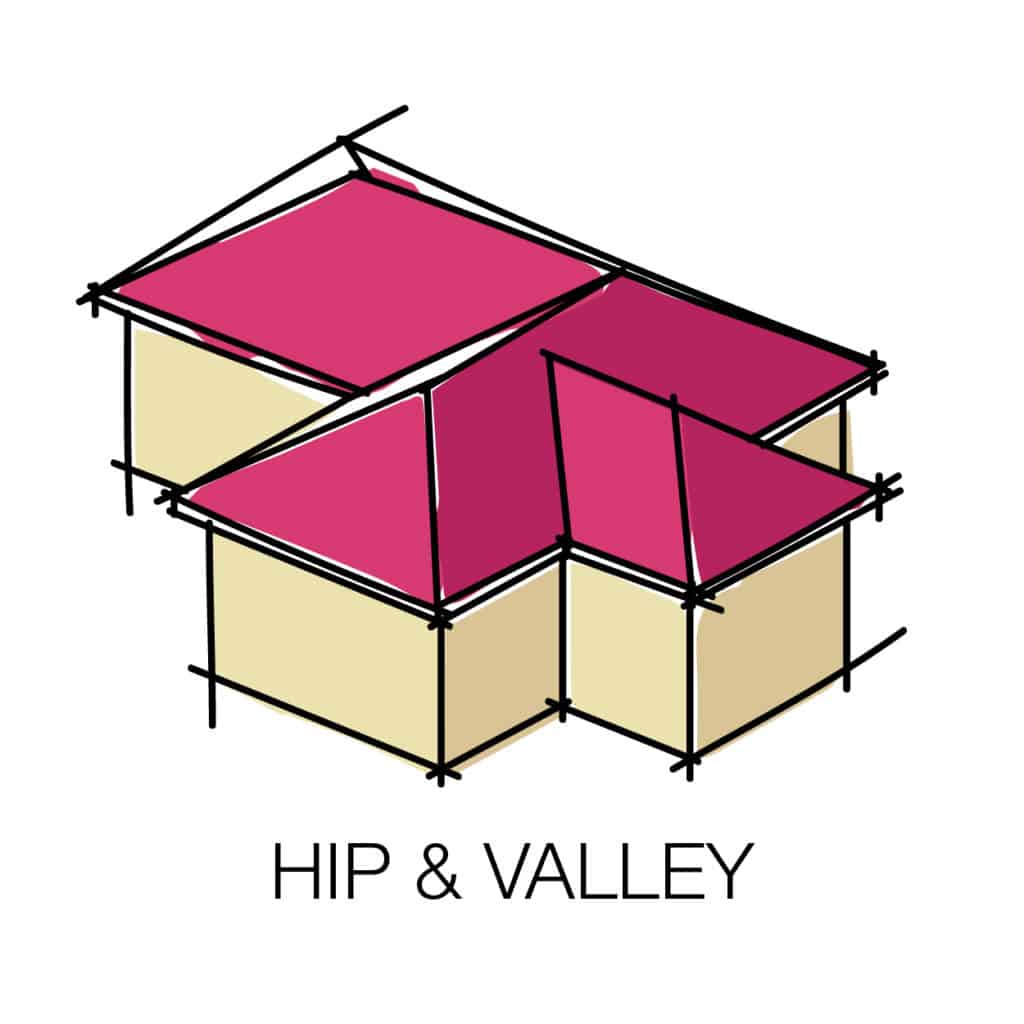
You can think of a hip and value roof as a modified or an extended version of a simple hipped roof. However, the difference in the roof structure is due to the shape of the building. If the building is not rectangular and is either T or L-shaped, then the hipped roof structure used for this building will be a Hip and Valley roof.
We understand that the explanation is a bit complicated, so we have also featured an illustration below to make things simpler. If you are interested in constructing a Hip and Valley roof for your building, then we suggest you take a look at this detailed guide.

via JW Roofing
7. Gambrel Roof
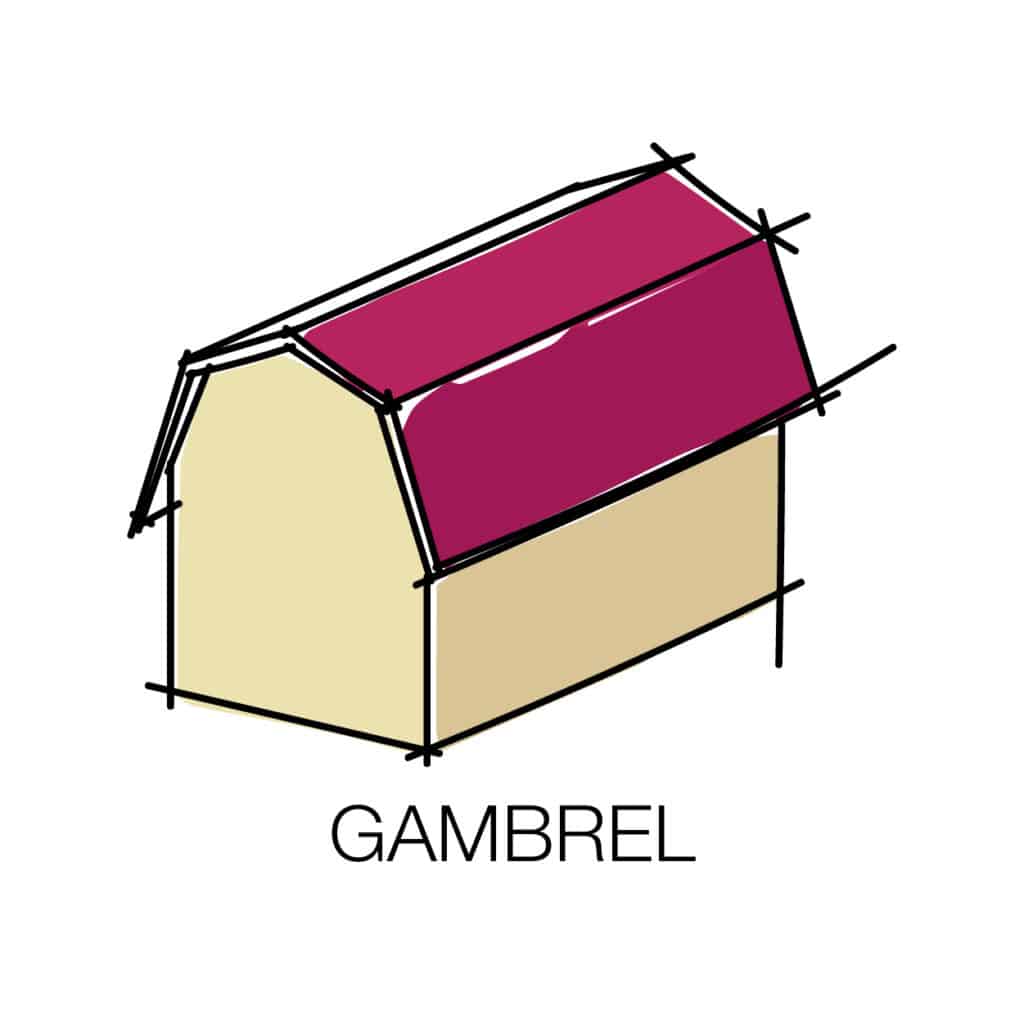
The Gambrel Roof is very similar to a standard gabled roof, however, instead of a single slope on each side, Gambrel roofs feature two slopes. This type of structure is commonly noticed in barn houses. The illustration presents a barn house-like structure with a standard gambrel roof.
In the case of gambrel roofs, the bottom slopes are more steeply raked compared to the top ones. This design philosophy results in increased attic space compared to a similarly sized building with a Gable roof.
However, there are some downsides to this design choice as well. The most obvious one is the price as gambrel roofs are usually more expensive to construct compared to a simple gabled roof. Moreover, gambrel roofs are less weather resistant compared to a Gable or hipped roof structure.
8. Mansard Roof
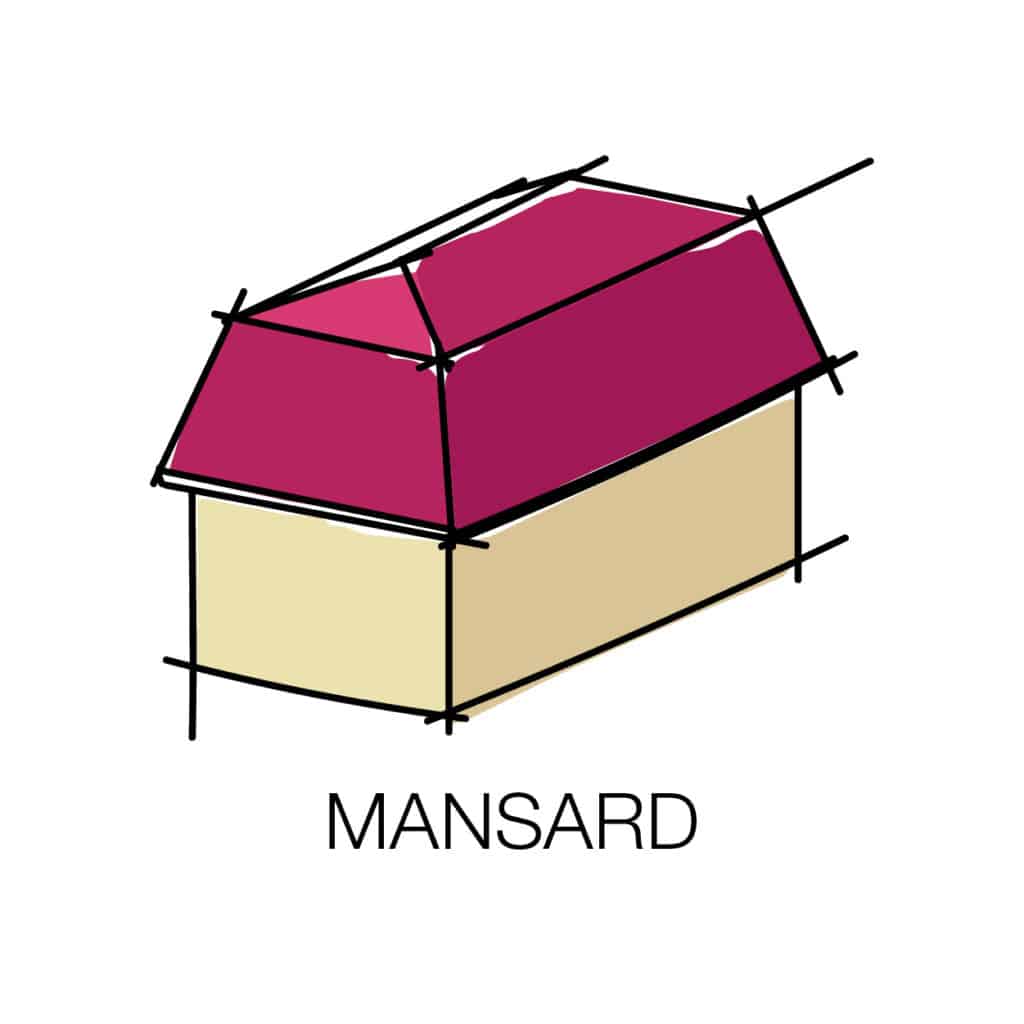
You can think of the Mansard roof as a mixture between a hipped roof and a gambrel roof. Why do you ask? Well, unlike a standard gambrel roof which has sloping edges on two sides of the building instead of all four, a Mansard roof has sloping edges on all sides. The sloping edges are exactly like that of a gambrel roof. In other words, each side of a Mansard roof has two slopes, out of which the bottom slope is steeper than the top one.
Mansard roofs also go by the name French roofs as this style was popularized in France by architect François Mansart. You can see buildings sporting the Mansard roof commonly in many European countries, including France.
Despite its usage in many aristocratic buildings, Mansard roofs are not that popularly used in normal homes. Not only are they much more expensive compared to the more popular roof structures, they are also quite complicated to construct. If you are looking to install a Mansard room in your building, then we suggest you consult with an experienced professional first.

Source Unknown
9. Butterfly Roof
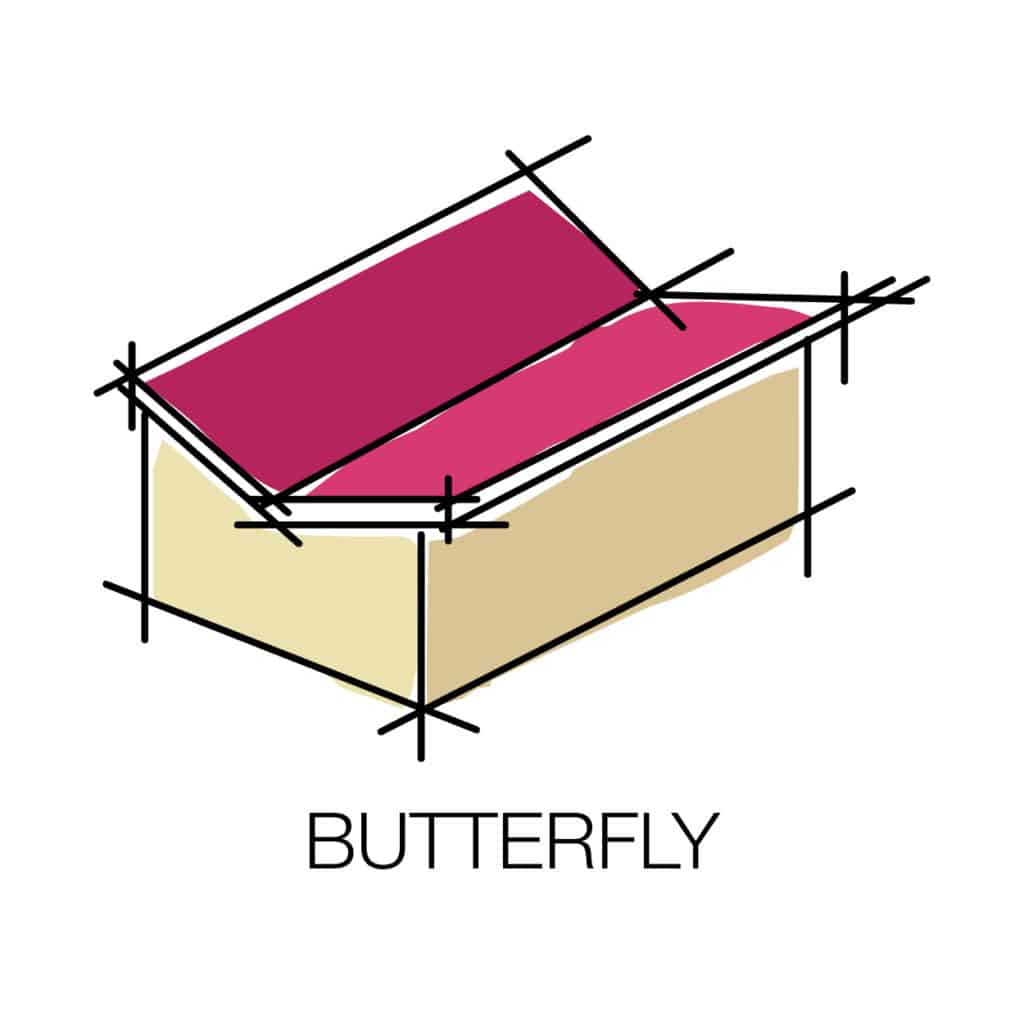
Simply put, a Butterfly roof is nothing but an inverted Gable roof. This type of roof structure is quite new compared to other roof structures featured on this list and was popularized by William Krisel and Dan Palmer in the late 1950s. The first Butterfly roof was created by a Swiss-French architect named Le Corbusier, who used it for a vacation house in Chile in 1930.
While beauty lies in the eye of the beholder, the practicality of the Butterfly roof's design cannot be questioned. This roof structure allows more natural light to enter the house and results in greater interior space well, moreover, it is also effective in collecting rainwater.

via hunker
10. Dutch Gable Roof

A Dutch Gable roof or a Gablet is a fusion between a hipped roof and a Gable roof. As you can see in the illustration below, the Gable portion sits on top of the Hip Roof. Now, there are quite a few advantages to this design philosophy.
Since a standard Hip Roof offers less attic space, the gable portion makes sure that the house has comparatively greater attic space. Moreover, the Hip structure on the bottom gives the entire roof more rigidity and that results in greater weather resistance. On top of that, the hipped part of this roof creates a covered porch area, as observed in the image below. In other words, a Dutch Gable roof combines the strength of both gable roofs and hip roofs and eliminates most of the drawbacks as well.

via houzz
11. Hexagonal Gazebo Roof
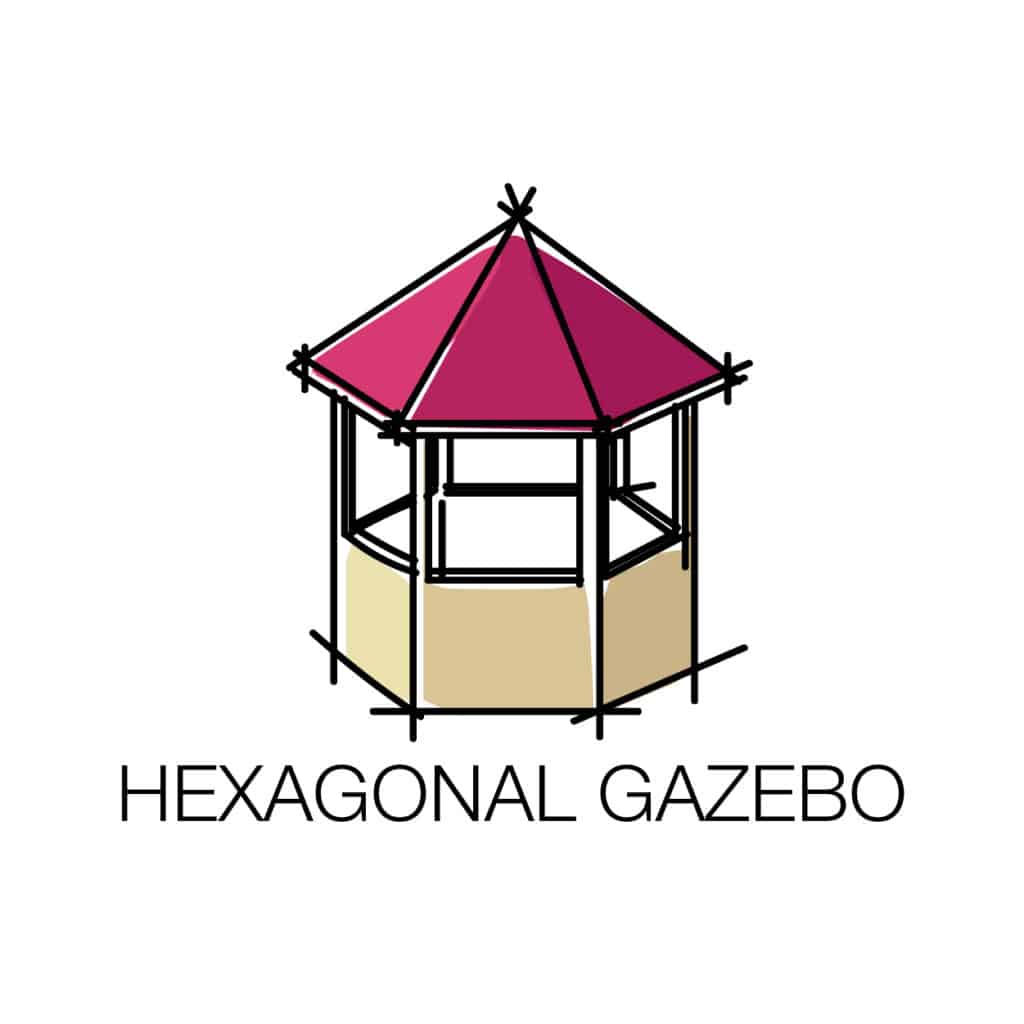
Hexagonal Roofs are not fit for every house. In fact, they are mainly designed for improved aesthetics rather than practicality. One of the most common places you will see a hexagonal roof is in a pavilion structure like a Gazebo. The illustration below shows us a beautiful Gazebo with a Hexagonal roof on top.
12. Jerkinhead Roof
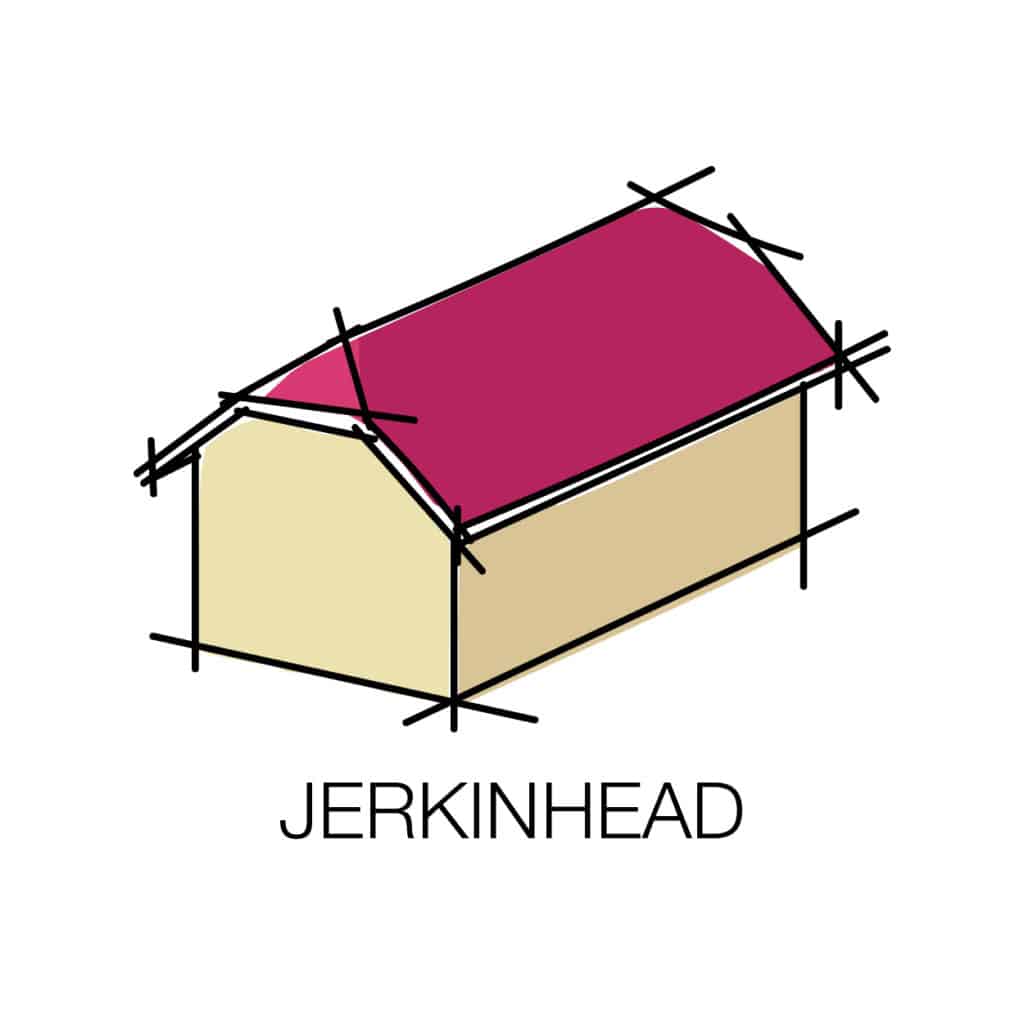
The Jerkinhead Roof is a mash-up between a Gable roof and a Hip Roof. However, unlike the Dutch Gable, which is also a fusion of the same, Jerkinhead roofs have a large gable with clipped edges. These clipped edges resemble a hipped roof structure.
Now, the benefits of this design are increased attic space compared to a standard Hip roof and greater wind stability due to the Hip roof structure. However, as you can see from the illustration, Jerkinhead roofs have a complicated design and that makes it much more expensive to construct compared to a standalone Gable roof or a Hip roof.
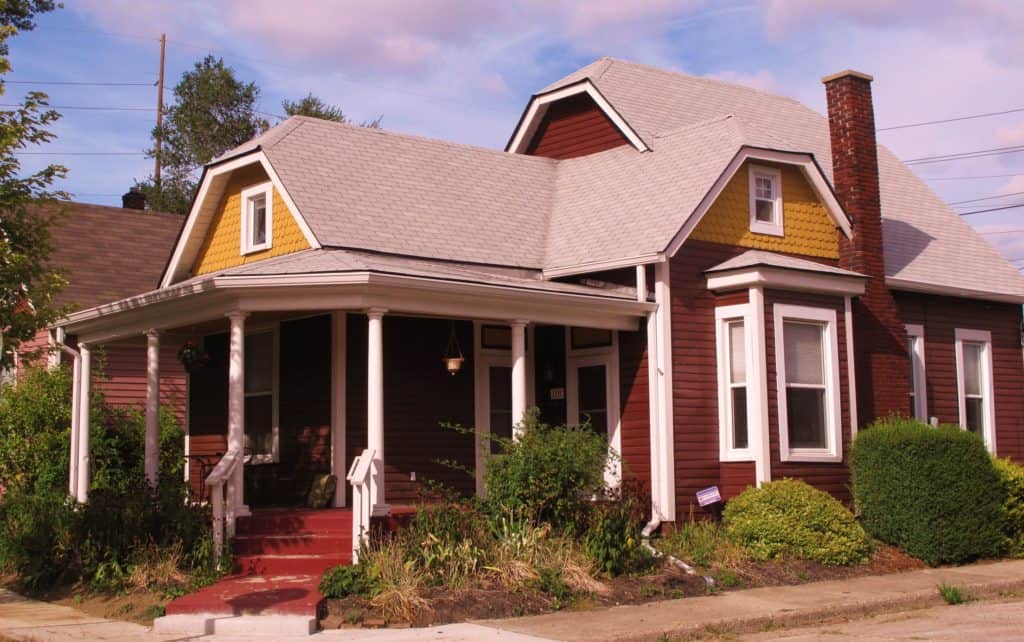
via Memphite
13. Clerestory Roof
The Clerestory roof is quite similar to the Skillion and Lean-to Roof we covered earlier. However, unlike a standard Skillion and Lean-to Roof, the Clerestory roof features a row of windows on the top as you can see in the illustration below. Since the windows of a Clerestory roof are placed very high up, they do not invade your privacy by any means.
So, what is the function of the windows? Well, they are there to fulfill a single purpose, and - you guessed it - it is to let a ton of natural light into the building. Moreover, as a result of the excess natural light, the room stays warm during winter months as well.
 via Pinterest
via Pinterest
14. Saw-tooth Roof
Although Saw-tooth roofs were usually used in industrial buildings, this design philosophy has slowly trickled down into eco-friendly homes. By definition, a saw-tooth roof is comprised of a series of ridges with vertical glass windows that meets a pitched roof. So, what are the benefits of this roof design?
Well, just like Clerestory roofs, Saw-tooth roofs are also built with natural light in mind. However, unlike Clerestory roofs which have only one set of windows, Saw-tooth roofs feature vertical windows on each segment.
If you are deciding between a Clerestory roof and a Saw-tooth roof, we would suggest going for the latter only if your house is extremely wide. Otherwise, a Clerestory roof will be better suited. Plus, you will also save some cash.

via Pinterest
15. Flat Roof

Although flat roofs are quite commonly used in commercial and other industrial buildings, they are also used in many residential houses. Surprisingly, they are installed in both high and low-rainfall areas. However, if you live in an area with heavy rainfall and snowfall, we would advise you against it. Instead, you should go for a Hip roof or any of the other weatherproof roofs featured on our list.
Another interesting fact about flat roofs is that they are not completely flat. In fact, they have a slight incline to not allow water to collect on it. In case you live in an area that is free from harsh weather conditions, then you can definitely install a flat roof. Moreover, you can use the flat space on top to make your house even more practical. For example, you can install PV Solar Panels on top of your flat roof to make your house energy efficient or even energy independent.

via Pinterest
16. M Shaped Roof
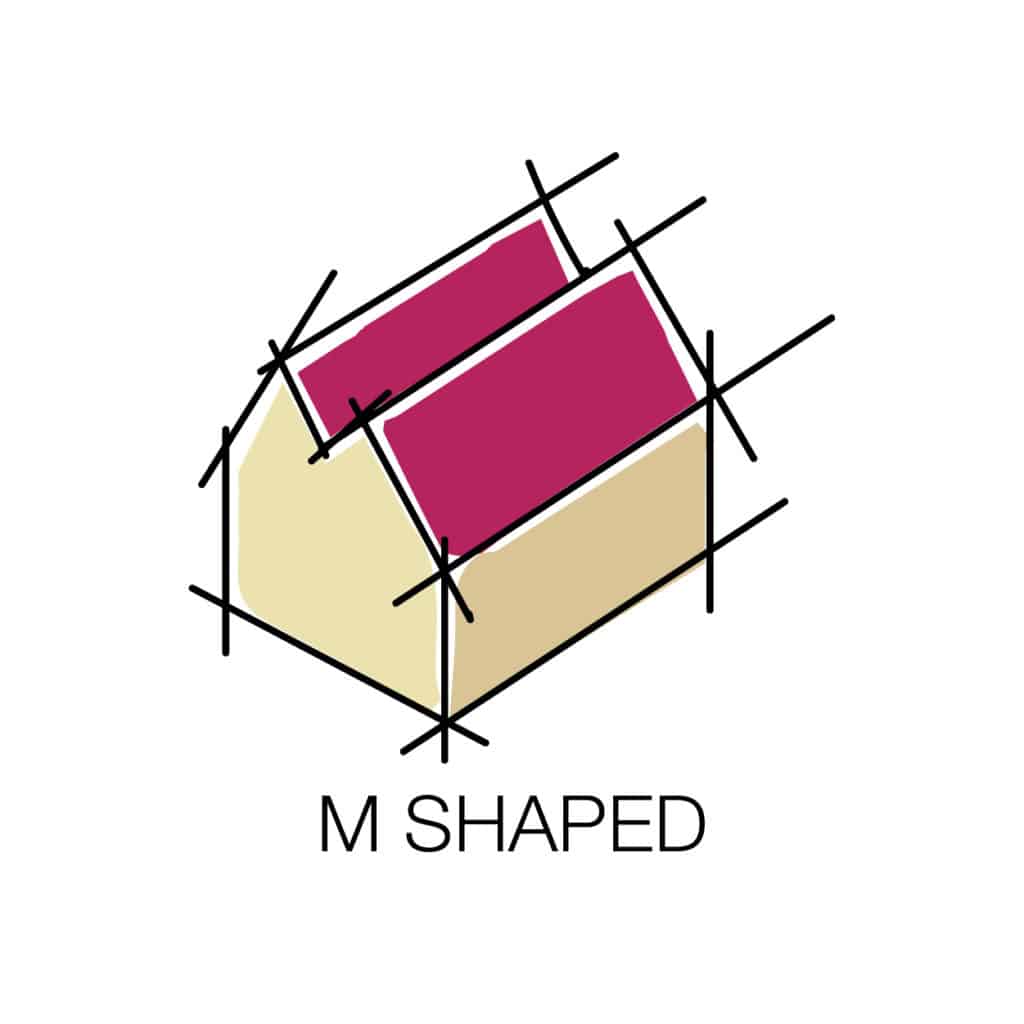
As its name suggests, M Shaped Roofs resemble the letter M. Well, not exactly a vertical M, but it is more akin to a flattened M. In other words, M-shaped roofs are nothing but two connected gable roofs. Now, the design of the M-shaped roofs leads to an obvious downfall which would be the meeting point of the two gables.
Needless to say, snow and rain will definitely build up in this area. Although, that can be countered to some extent with the use of a central gutter. In areas of high rainfall and snowfall, the pitch of M-shaped roofs is usually much steeper and this ensures that it catches less rain and snow.
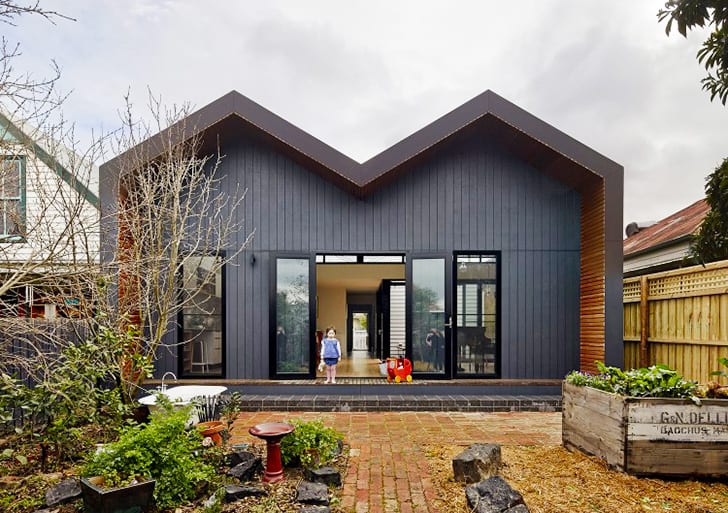
via inhabitat
17. Saltbox Roof
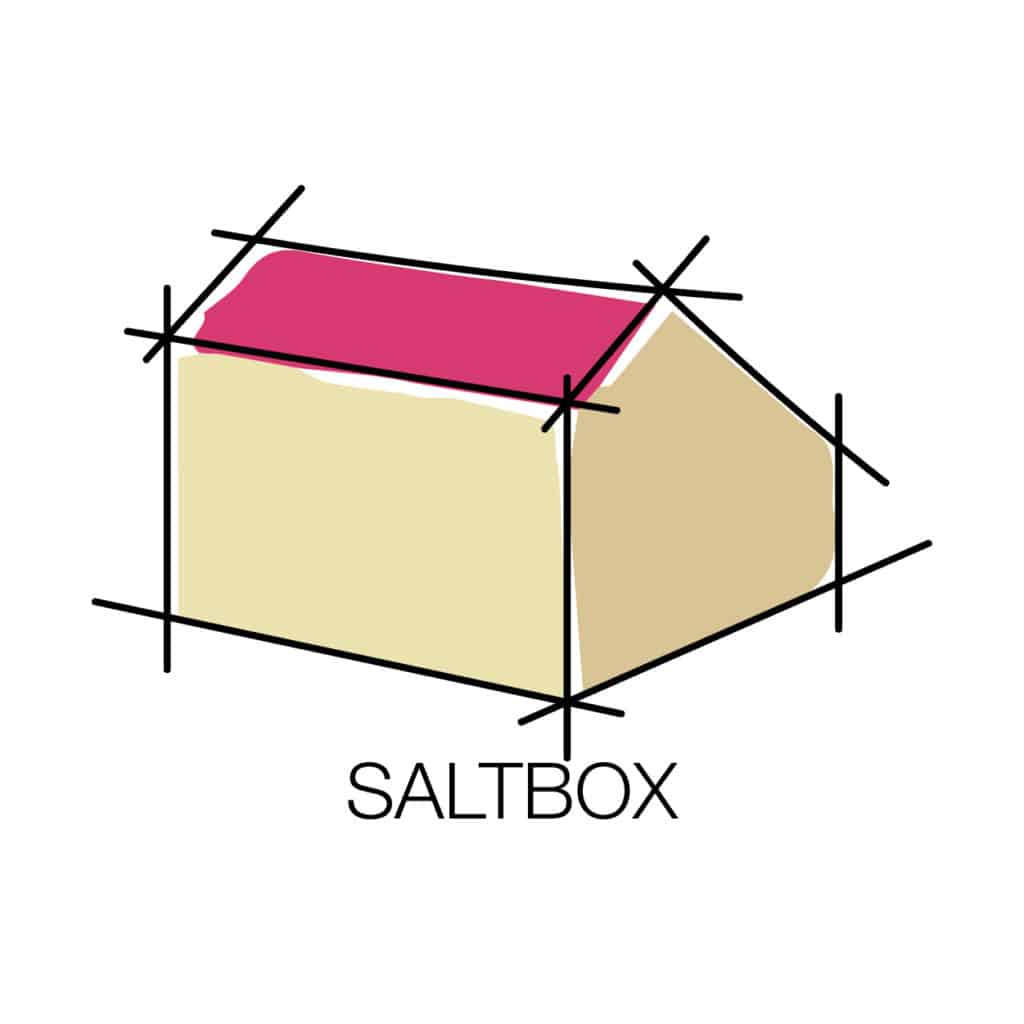
Saltbox roofs are quite common in New England. In fact, the first Saltbox house originated in New England and is an example of American colonial architecture. Saltbox roofs are quite similar to Gable roofs, however, unlike Gable roofs which have symmetrical slopes on either side, these roofs have asymmetrical slopes. Take a look at the illustration below, the right slope is much longer than the left one.
This design philosophy leads to a few problems. The interior space on the back side of the house is quite limited due to the roof almost extending to the ground. Moreover, the tricky design also leads to increased costs.
However, there are a few redeeming qualities that make this roof style desirable. Saltbox roofs are usually more durable than standard gable roofs owing to their asymmetrical design. On top of that, the large slope makes it easy for water to run off and you can collect a lot of rainwater if you live in an area with heavy rainfall.
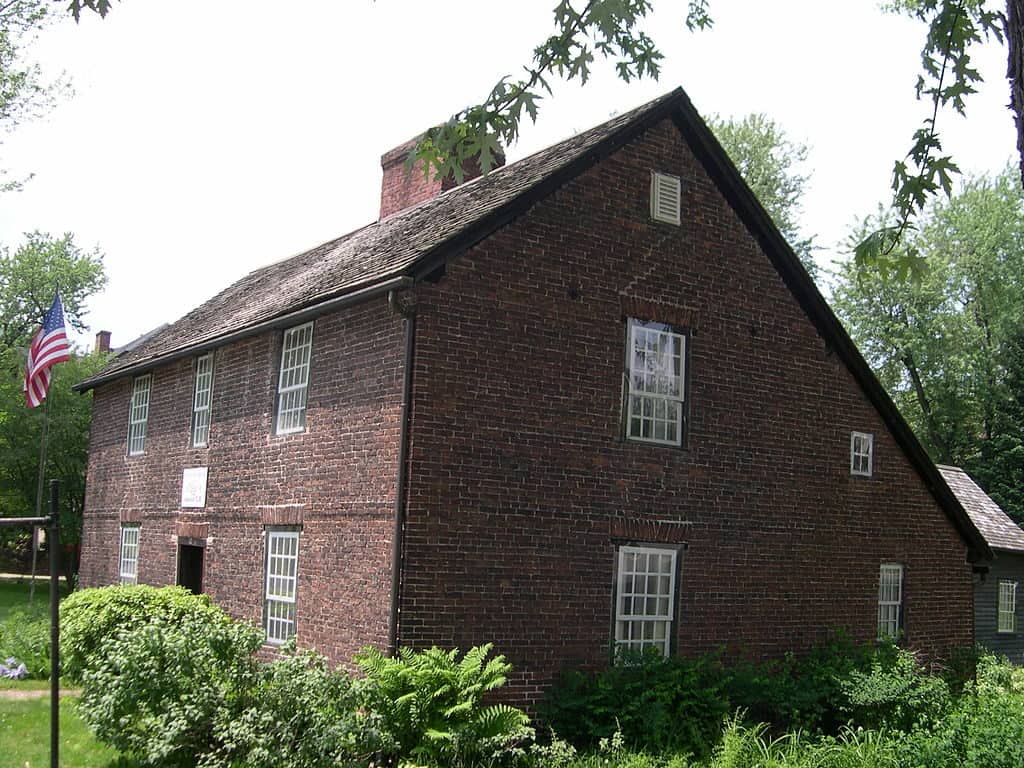
via Wikipedia
18. Shed Roof or Skillion Roofs
Shed roofs, also known as Skillion roofs, have a single slope, as you can see in the illustration below. Many modern homes prefer to have this kind of roof style as it not only offers more interior space as opposed to a gable roof or a hip roof, but it can look quite sophisticated as well. Moreover, shed roofs allow more natural light inside compared to pitched roofs.
Another benefit of installing Skillion roofs is simplicity. These roofs are easy to assemble and do not need as many building materials as some of the other roof styles. However, if you live in an area prone to tornadoes or hurricanes, we would suggest you go for a more windproof roofing style like a hip roof.
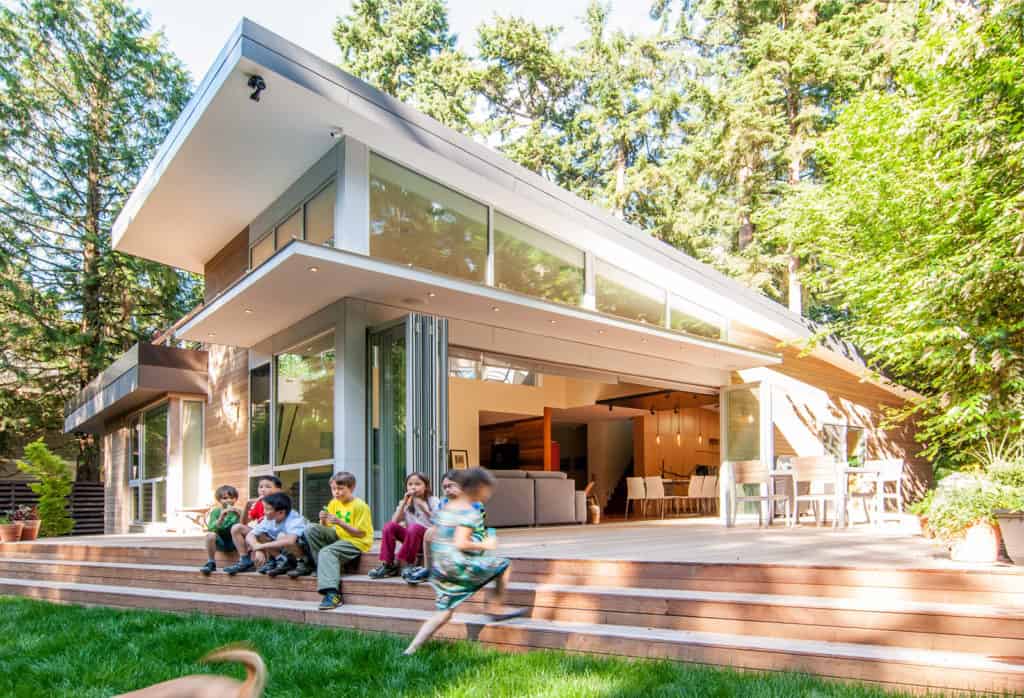
via BuildLLC
19. Combination Roofs
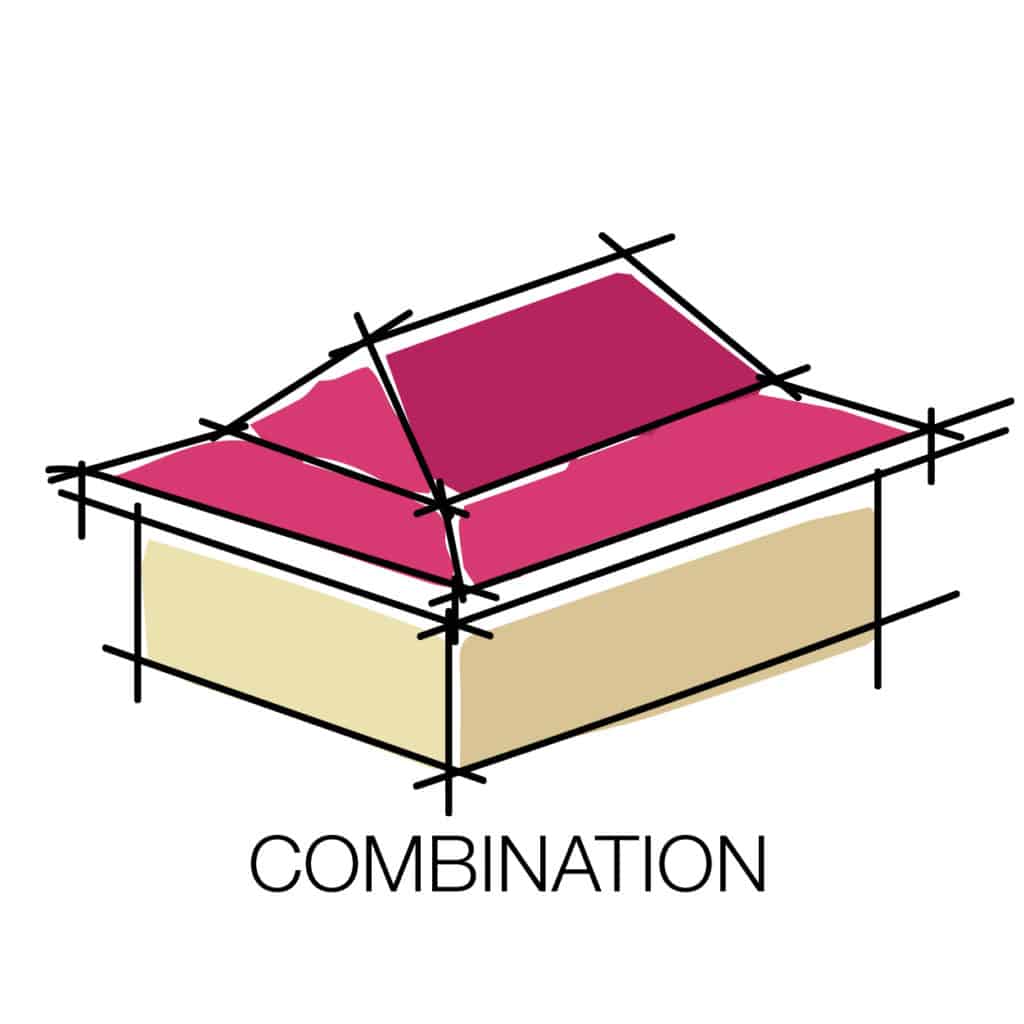
As its name suggests, combination roofs are an amalgamation of simpler roofing styles. Take a look at the illustration below, for example, it incorporates multiple gable roofs along with a hip roof for the front porch. Combination roofs are more suitable for complex architecture.
However, the complexity of the roof structure leads to an obvious downside: the cost. Moreover, building such roofs requires roofing experts and cannot be attempted by an amateur. On top of that, if there are multiple valleys in the roof, it can lead to water damage through those weak points.
20. Pyramid Hip Roof
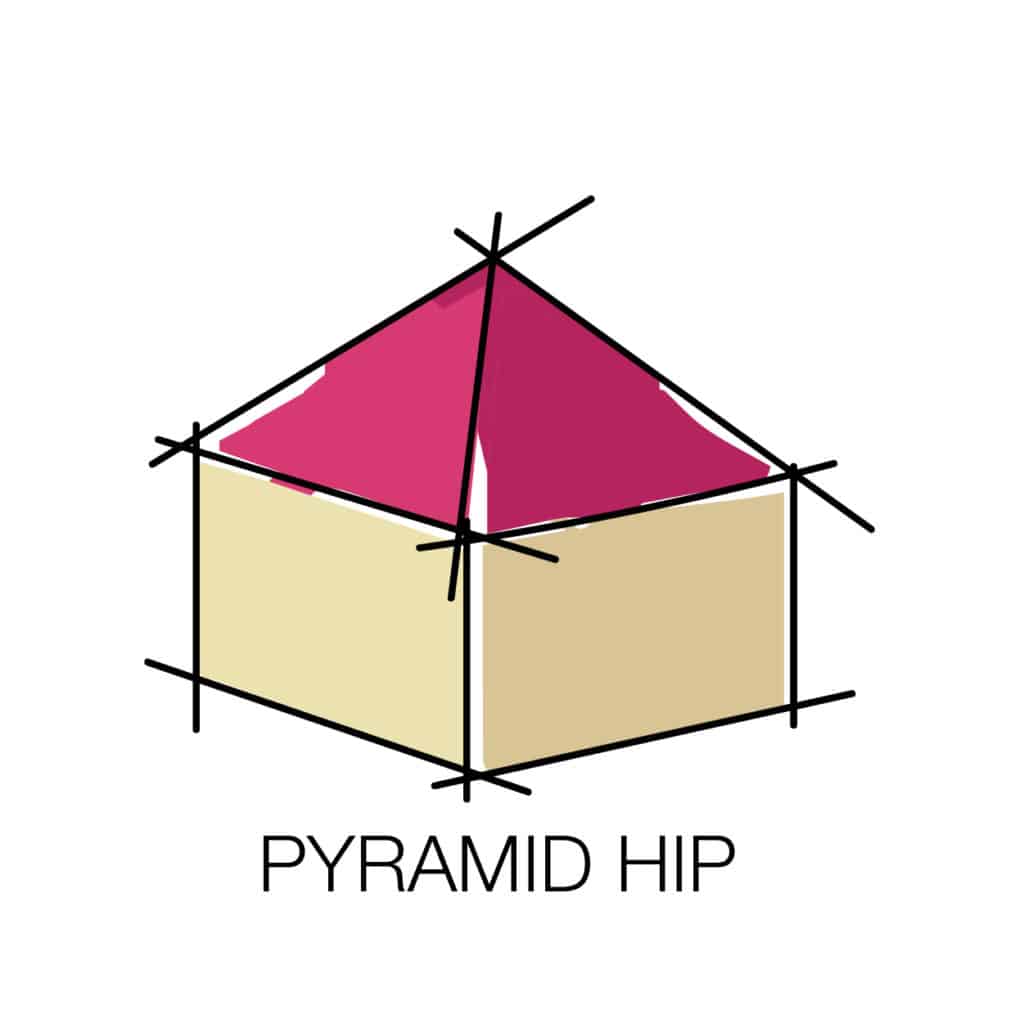
Last but not least, is the Pyramid Hip Roof, and as its name suggests this roof closely resembles a pyramid structure. You can think of this roof as a special case of a standard hip roof. Normally, in the case of hip roof, the four sides of the roof converge in the center thus creating a ridge. However, in the case of a Pyramid Hip roof, the four sides converge to a single point, as you can see in the illustration below.
If you live in an area with harsh environmental conditions, then Pyramid roofs will have you covered. They are extremely resistant to strong winds. However, the downside of a Pyramid Hip roof is the complexity of the design which leads to increased costs over a standard Hip roof or a Gable roof.
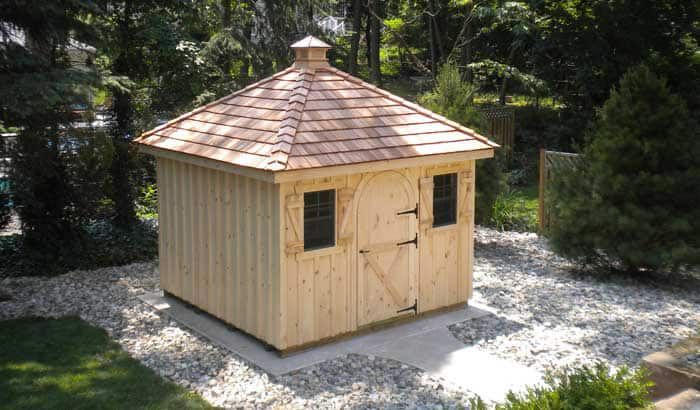
via Lapp Structures
With that, our article has come to an end. Now that you have read through this article you ought to be better prepared to choose the correct roofing structure for your home. Before we bid adieu, remember that roofs are extremely important, they`re not there just to improve the aesthetics of a building. It is highly recommended to go the extra mile and splurge on the roof best suited to your needs.
What roof types you`ve noticed in your area and what roof types do you think you actually need?
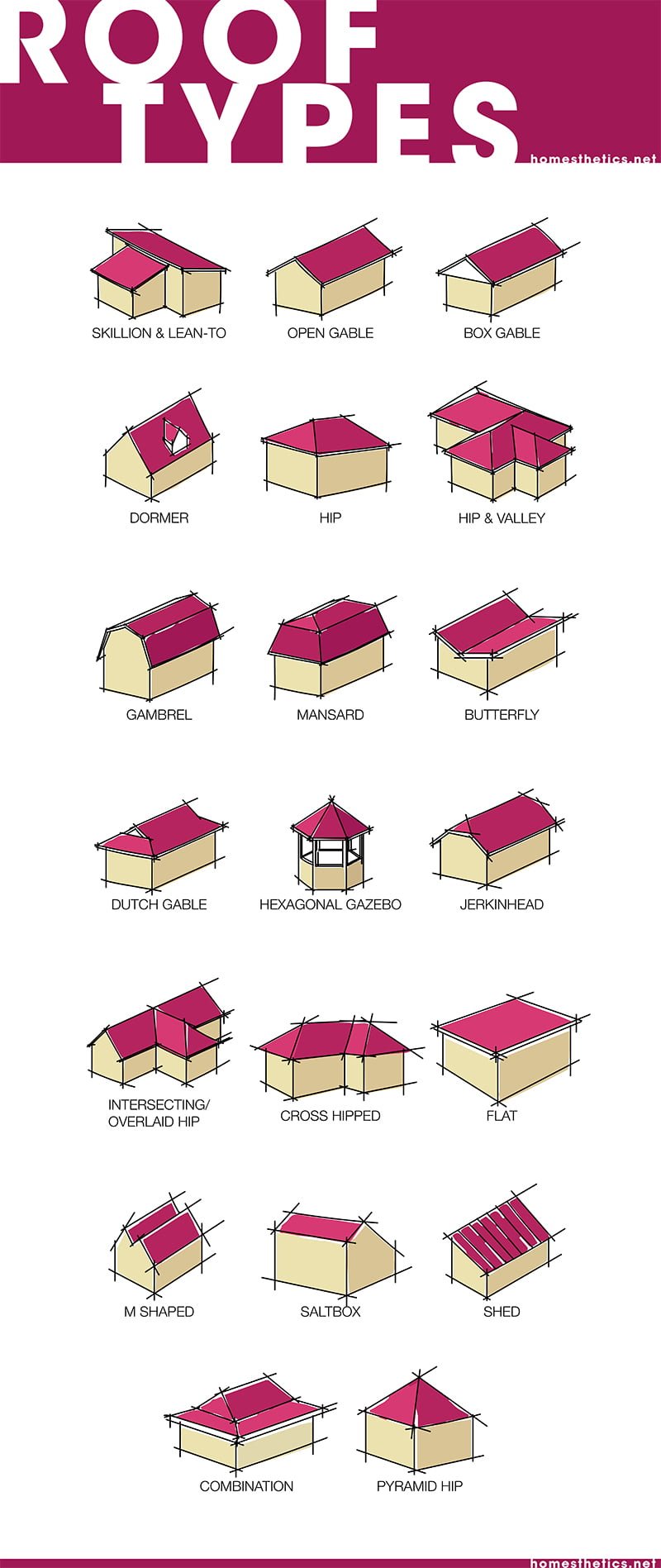
Related Articles
23 Hip Roof Types & Styles for Your Future Home
What is the Mansard Roof, Advantages and Disadvantages Sheltered
6 Eco-Friendly Roofing Materials and Why You Need Them
How To Clean Gutter Guards Efficiently
Shur Flo Gutter Review | All You Need to Know
EasyOn Gutter Guard Review 101 | All You Need to Know
5 Best Foam Gutter Guards [Reviewed & Buyer’s Guide]
23 Extraordinary Beautiful Ways to Repurpose Rain Gutters in Your Household



 via
via 